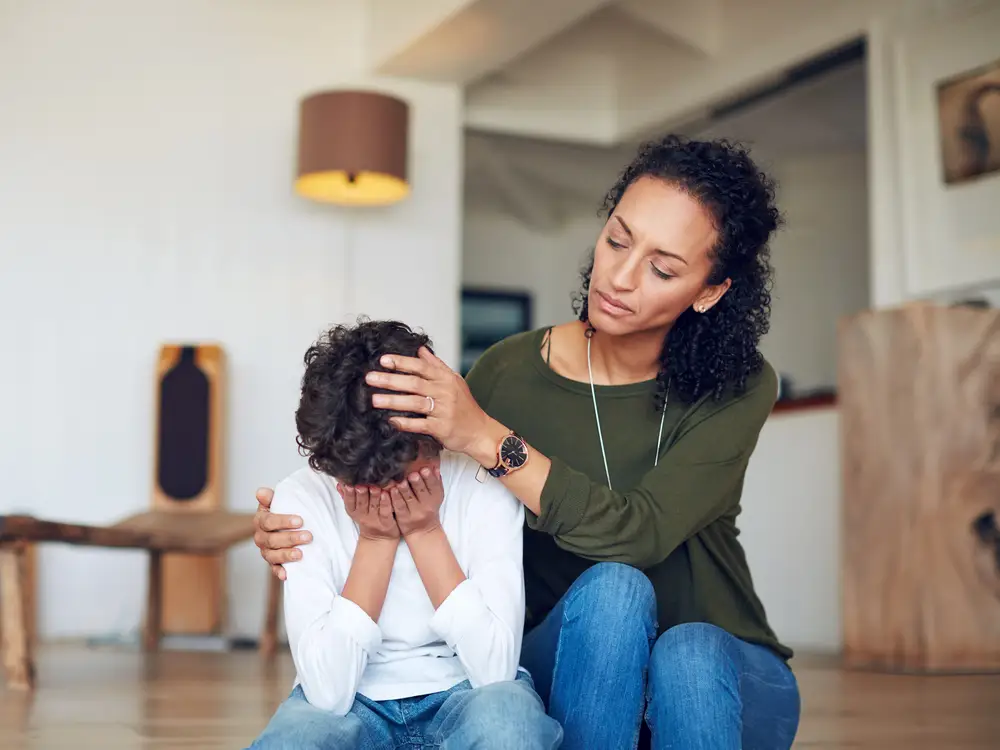Kids won’t always be happy, and that’s OK. Allowing room for the full range of emotions sends an important message.

Our kids are allowed to express a range of emotions.
One thing we’ve noticed with our six kids is that each has a different emotional baseline. One is usually excited and upbeat, while another is usually calm and serene. We’ve learned that our kids bring different moods and emotions at different times to the table, and we try not to expect or insist on the same baseline from everyone.
Our feelings are just that: feelings. It can be tempting to categorize feelings as “positive/good” (like happiness, joy, pride) and “negative/bad” (like sadness, anger, frustration) and conclude that we should seek to maximize the “positive” feelings and minimize the “negative” ones. But feelings aren’t really like that.
Feelings aren’t bad and therefore to be avoided, or good and therefore to be sought after; feelings just are. Feelings are more like facts. A loved one dies, and we feel sadness and grief and maybe anger. We get rejected from a program we worked hard to apply to, and we feel disappointed, frustrated, or defeated. Not every emotion can or should be immediately metabolized into something more palatable.
We can feel “happy” in response to simple events like seeing a beautiful sunset, hearing birds sing, smelling a fragrant flower, or learning it will be a cloudless night when we have scheduled to watch the Perseids meteor shower.
We can respond in a way that lets us appreciate these moments, like putting down our work to watch the sunset and remembering to literally smell the roses. But happiness is a fleeting feeling — all feelings are — and largely out of our control. We can’t engineer these feelings of happiness to happen as frequently as we might like, and we certainly can’t do it for our children.
Always being happy is not the goal
While we don’t see our work as parents to be constantly monitoring our child’s feelings, and working to ensure they are positive, at least a part of our work is to help our child to participate in meaningful work. For us, projects we work on together as a family are good models for the role of emotions: We’re not always happy when we work together on a project. And “being happy” is not an aim of our collaborative work. After all, the work usually involves difficult, objectionable, or tedious work (like clearing out an attic, removing wallpaper, cleaning out a drain, or taking a load of heavy bags to the dump).
In the course of doing this work, we routinely run into frustrating complications and setbacks, and frequently enough we discover another involved project we’ll need to tackle that we hadn’t planned on, like when we were preparing to sand the floor in a room, only to discover that the floor needed to be replaced entirely. Our expectations aren’t related to a child’s emotions, but rather to their participation. We try to show them how to participate and expect them to contribute meaningfully.
The result of working together is usually increased competence in the specific work involved and competence working with one another. At the end of the best projects, when we can all see the difference our work has made, we experience a sense of satisfaction and fulfillment together.
While this satisfaction is rewarding and can be a partial motivator for future projects, it is definitely not the predominant feeling throughout. It is not the reason or justification for the work. It is mostly reserved for the very end. And there are plenty of projects with no collective cheer of satisfaction at the end. But that’s OK. It’s a bad bargain to exchange the expectation of a continued feeling that is by nature fleeting, for an enduring relationship.
We embrace the unavoidable challenges of life
If we are overly concerned that our kids feel happy all the time, we might not ask them to participate in the difficult work where the sense of satisfaction and fulfillment comes only at the end. A more serious risk to insisting that a child is always happy, or believing that, ideally, a child should always or usually be happy — beyond its futility — is that it can ironically convey the message to our child that their “happiness” is a condition of our relationship.
A much more valuable message to communicate with our children is that, because of our many shared experiences across a range of activities and emotions, we can trust and be at ease with one another, independent of our feelings.
One message that depression (which we have personal experience with) communicates that is true is that life is hard. We all experience distress at work or school. We’ll run into relationship drama. Our feelings will be hurt. We’ll have to deal with pangs of regret because of things we said or did. We’ll feel lonely, self-conscious, and bored. Along with these everyday hardships, there is also a lot of real horror in the world. While violence and suffering have thankfully decreased over time, today, we’re much more aware of incidents of violence and suffering than we ever could have been before.
Across the political spectrum, people, including children, have become increasingly worried or pessimistic about the future of politics, and political rhetoric has stoked these fears (even if only when imagining the opposing party winning).
We don’t mean to be dramatic about this or to suggest that we should expect all children to be Eeyores, but this context can be a helpful check if we’d assumed that our children should always, or usually, be happy. There will be times when your child feels crummy about their future, and that’s valid. They get to feel that, and we don’t have to try to take those bad feelings away, even if it can be trying to sit with someone who is experiencing “negative” feelings.





